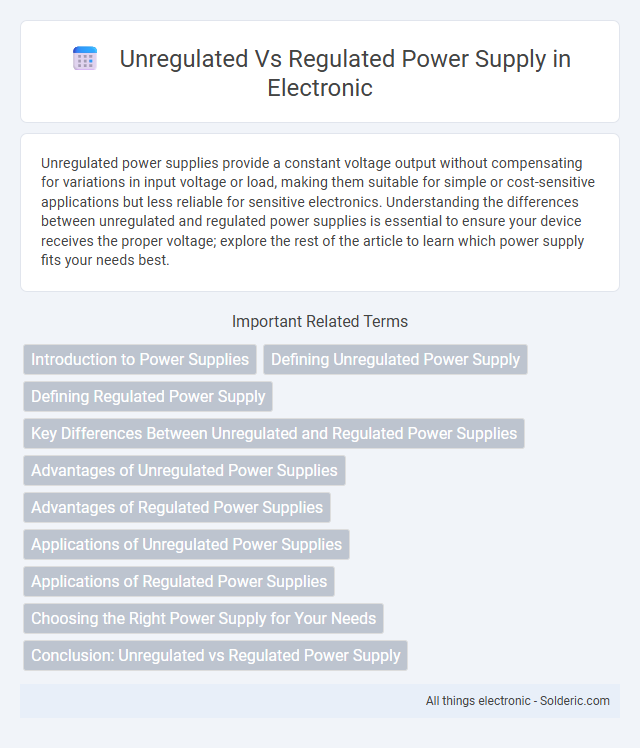Unregulated power supplies provide a constant voltage output without compensating for variations in input voltage or load, making them suitable for simple or cost-sensitive applications but less reliable for sensitive electronics. Understanding the differences between unregulated and regulated power supplies is essential to ensure your device receives the proper voltage; explore the rest of the article to learn which power supply fits your needs best.
Comparison Table
| Feature | Unregulated Power Supply | Regulated Power Supply |
|---|---|---|
| Output Voltage | Varies with load & input voltage | Maintains constant voltage regardless of load |
| Voltage Stability | Low stability, fluctuates under varying load | High stability, stable output voltage |
| Complexity | Simple circuit design | More complex circuitry with regulation components |
| Cost | Low cost, inexpensive components | Higher cost due to added regulation parts |
| Applications | Suitable for applications not sensitive to voltage variation | Ideal for sensitive electronic devices needing consistent voltage |
| Heat Dissipation | Less heat due to simpler design | More heat generation because of regulation |
| Response to Load Changes | Output voltage drops or rises significantly | Output voltage remains stable with load variations |
| Efficiency | Generally higher efficiency, fewer active components | May have lower efficiency due to regulation losses |
Introduction to Power Supplies
Unregulated power supplies provide a raw, unfiltered voltage output that fluctuates with input voltage and load changes, making them less stable for sensitive electronics. Regulated power supplies use feedback control systems to maintain a constant output voltage regardless of input variations or load demands, ensuring reliable performance for your devices. Choosing the right power supply impacts the efficiency, safety, and longevity of your electronic equipment.
Defining Unregulated Power Supply
An unregulated power supply delivers a variable voltage output that fluctuates with changes in input voltage and load conditions, lacking built-in mechanisms to maintain steady voltage levels. This type of power supply is typically simpler and less expensive but can lead to unstable performance in sensitive electronic devices. Your applications requiring consistent voltage performance benefit from understanding the limitations of unregulated power supplies compared to their regulated counterparts.
Defining Regulated Power Supply
A regulated power supply maintains a constant output voltage regardless of variations in input voltage or load conditions, using feedback control mechanisms such as voltage regulators. It ensures stable and reliable electric power for sensitive electronic devices by minimizing voltage fluctuations and noise. Unlike unregulated power supplies, which provide raw power without voltage stabilization, regulated power supplies improve performance and protect circuitry from damage.
Key Differences Between Unregulated and Regulated Power Supplies
Unregulated power supplies provide output voltage that varies with input voltage and load changes, resulting in less stable performance, while regulated power supplies maintain a constant output voltage regardless of input fluctuations or load variations. The key difference lies in regulation circuitry; regulated supplies use feedback control to stabilize the output, enhancing reliability for sensitive electronic devices. Your choice depends on whether precision and stability are critical, as regulated power supplies offer superior voltage consistency compared to unregulated types.
Advantages of Unregulated Power Supplies
Unregulated power supplies offer simplicity, lower cost, and higher efficiency due to minimal internal components and lack of voltage regulation circuitry. Their straightforward design provides faster response to changes in load without added complexity, making them ideal for applications where precise voltage control is unnecessary. You benefit from their compact size and reliability in basic electronic projects or devices that tolerate voltage variations.
Advantages of Regulated Power Supplies
Regulated power supplies maintain a constant output voltage regardless of variations in input voltage or load conditions, ensuring stable and reliable performance for sensitive electronic devices. They minimize voltage fluctuations, reduce noise, and protect circuits from damage caused by voltage spikes or drops. Enhanced precision and improved efficiency in energy delivery make regulated power supplies essential for applications requiring consistent power quality.
Applications of Unregulated Power Supplies
Unregulated power supplies are commonly used in applications where cost efficiency and simplicity outweigh the need for precise voltage control, such as in battery charging, simple test equipment, and basic LED lighting systems. These supplies provide a constant, unfiltered DC output after rectification and smoothing, making them suitable for devices tolerant to voltage fluctuations. Their widespread use in low-cost consumer electronics and industrial machinery highlights their practicality in scenarios requiring minimal regulation and durable performance.
Applications of Regulated Power Supplies
Regulated power supplies are essential in applications demanding stable voltage and current, such as medical equipment, communication devices, and precision laboratory instruments. These power supplies prevent fluctuations that could damage sensitive components or distort performance. Industries in electronics manufacturing and testing rely heavily on regulated power supplies to ensure consistent operation and accuracy.
Choosing the Right Power Supply for Your Needs
Unregulated power supplies offer simplicity and cost-effectiveness but may produce voltage fluctuations under varying loads, making them suitable for basic applications. Regulated power supplies provide stable and precise voltage output, essential for sensitive electronics and devices requiring consistent performance. Selecting the right power supply depends on your device's voltage stability requirements and tolerance for load variations.
Conclusion: Unregulated vs Regulated Power Supply
Unregulated power supplies deliver varying voltage levels depending on load changes, leading to potential instability in sensitive electronic devices. Regulated power supplies maintain consistent output voltage by compensating for fluctuations, ensuring reliable performance and protection of components. For critical applications requiring stable and precise power, regulated power supplies are the optimal choice over unregulated ones.
unregulated vs regulated power supply Infographic

 solderic.com
solderic.com